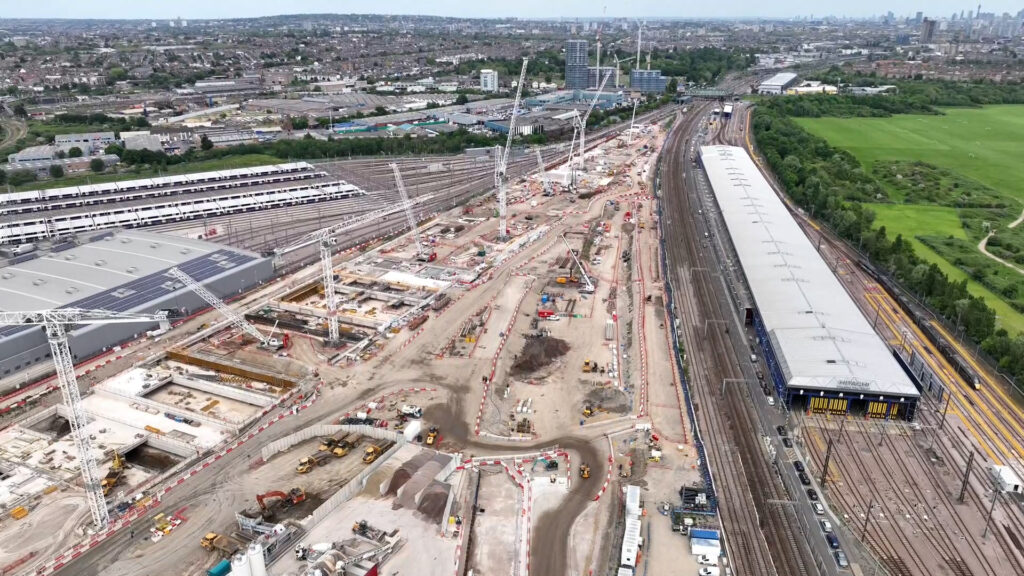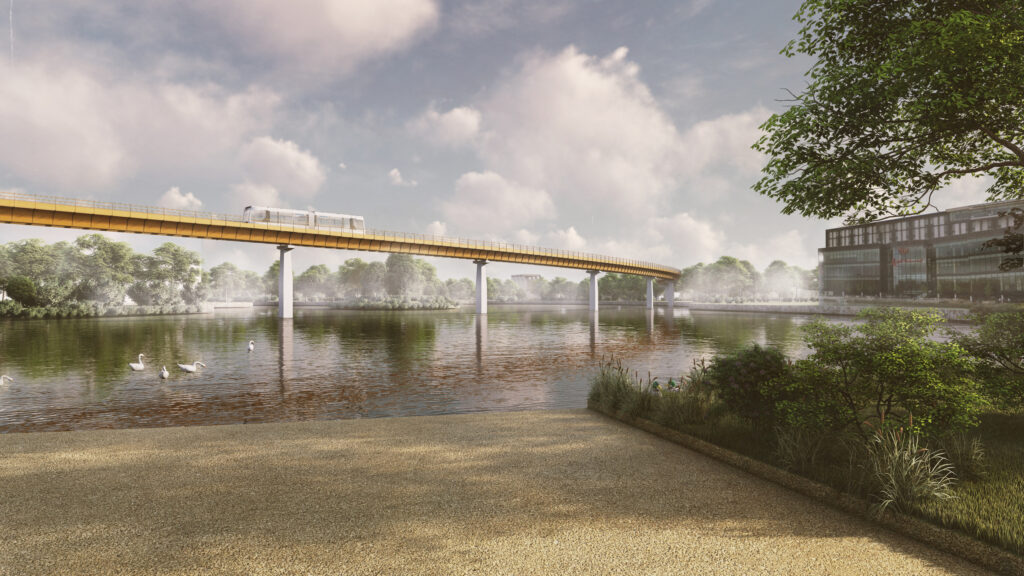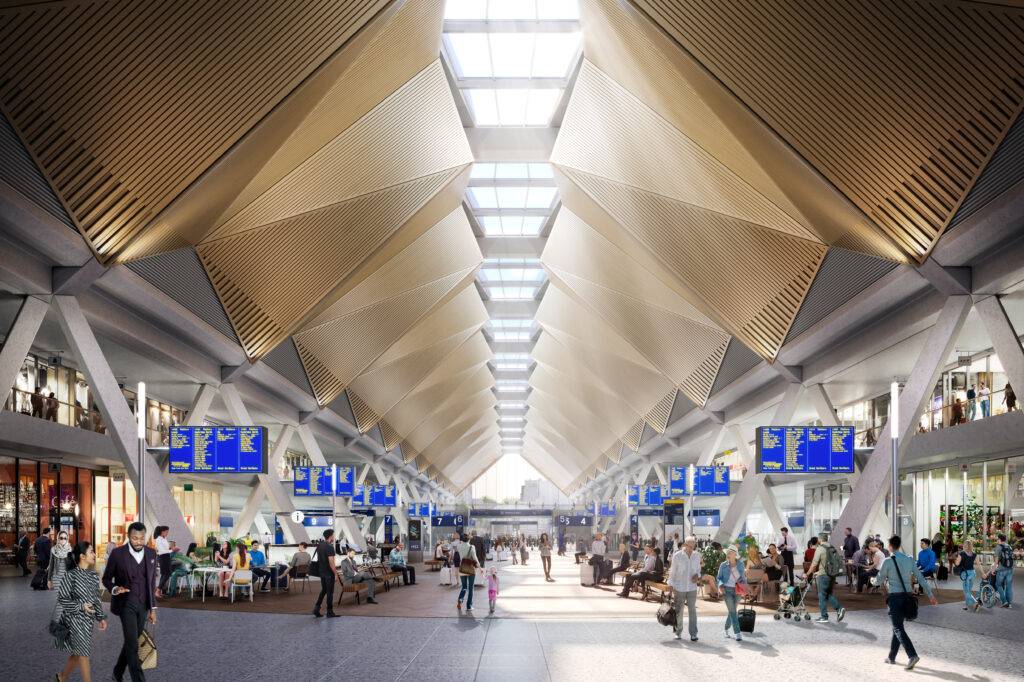HS2 phase one will eventually have four new stations in London and Birmingham. These stations are designed to be modern, spacious, and sustainable, accommodating the expected increase in passenger demand. As this high-speed project gathers pace, we take a look at the recent progress at three of these new stations and consider why it is likely that Euston will not see high-speed trains until 2040.
Old Oak Common, West London
HS2’s landmark station, Old Oak Common, celebrated a key milestone in June as it marked two years of permanent construction.
The ‘super-hub’ station is planned to be one of the busiest in the country with high-speed rail services to the Midlands, Scotland, and the North, and access to central London and Heathrow via the Elizabeth line. It will boast 14 platforms, six of which will serve high speed trains and will be situated below ground. These will sit within an 850-metre-long station box, large enough to house 6,300 Routemaster buses. There will be an integrated connection to the adjoining conventional station at ground level via a stylish shared overbridge, and a light and airy concourse will link both halves of the station.
In June 2021, Grant Shapps MP, then the Secretary of State for Transport, gave the thumbs up for permanent work to begin. Since then, work has gathered pace and significant progress has been made. A total workforce of 1,900 people now supports the delivery of the station, with the site itself welcoming around 1,000 workers each day.
In March, HS2’s Station Construction Partner, Balfour Beatty VINCI SYSTRA Joint Venture (BBVS JV) completed the installation of the 1.2-mile diaphragm wall for the underground box which will contain the six new high-speed platforms. The team installed 275 diaphragm wall panels and 161 bearing piles, the largest of these being 2.2 metres in diameter and 57 metres in length. The first base slab concrete pour in the western end of the station box took place in May, as reported in Rail Engineer 202 (May/June).

The excavation of the station box is also well underway with over 465,000m3 of London clay already removed out of a total of 930,000m3 from across the site. The excavated clay from the site is now being taken away via part of a 1.7-mile conveyor network, removing thousands of lorry movements from local roads.
Over 900 of the 1,600 concrete piles have been installed into the ground where the HS2 station superstructure and overground platforms for the conventional train network will be constructed. Piling work also began earlier this year on the second half of the station – the eight platforms that will be served by Great Western Mainline and Heathrow Express services. Platform construction will start later this year.
In addition to all of this, the demolition of the Wycombe Line Bridge, over Old Oak Common Lane, was completed at the end of May. The disused rail bridge was removed following a weekend road closure and makes way for the construction of the new Network Rail bridges which allow the Great Western Mainline track alignment to be widened as it approaches the new station.
“Here at Old Oak Common, we are well underway in our work to construct London’s newest super-hub station,” said HS2’s Project Client Director, Huw Edwards. “Our work is supporting nearly 2,000 jobs and we are already seeing that the new station is becoming a catalyst for regeneration in the Old Oak and Park Royal area.
“Upon completion, it will harness the close linkage with the newly opened Elizabeth Line, dramatically improving connectivity and creating a new destination to live and work in London.”
Later this year, the eastern end of the 10-hectare site will be handed over to HS2’s London Tunnels Contractor, Skanska Costain STRABAG joint venture (SCS JV), for the breakthrough of the Tunnelling Boring Machine, named Lydia, which will have completed the construction of an 850-metre-long logistics tunnel from the nearby Atlas Road site.
The SCS JV team will then receive two further TBMs delivered to Old Oak Common, in 2024, which will be assembled in the station box, ready to bore the five-mile Euston Tunnel.
A project update for Old Oak Common can be found here.
Curzon Street Station, Birmingham
On 17 July, Transport Secretary Mark Harper visited Birmingham with his Australian counterpart, Minister for Infrastructure, Transport and Regional Development, Catherine King. The pair were there to see the construction of HS2’s iconic new Curzon Street Station taking shape.
Built on the site of Birmingham’s 19th Century station at Curzon Street, the new station will be the first brand new intercity terminus station built in Britain since the 1800s. Curzon Street Station will welcome high-speed services into the heart of Birmingham city centre, connecting cities and towns across the West Midlands and beyond. Eventually, there will be nine trains per hour direct in each direction from the station.
Harper and King took an exclusive first walk on top of the grand, 300-metre-long HS2 viaduct to see first-hand the view passengers will witness when travelling into the city on HS2 trains. The walk marked a key construction milestone, celebrating the half-way point of the viaduct’s completion, which now has 15 of its 30 V-shaped piers in place.
Each pier takes up to four weeks to be fully installed on site, with the tallest pier reaching up to six metres above the ground. After the piers are in place, teams will begin to form the deck spans connecting the piers using system falsework and formwork with the longest span between each pier stretching over 28 metres across the site.
Curzon No.3 Viaduct is 65 metres at the widest point, and as it approaches the station, the deck widens from a single deck at the eastern end to four separate decks at the western end, creating opportunities for a usable, flexible public space with maximised daylight under the viaduct.

Once built, HS2’s Curzon Street Station will be one of the most environmentally friendly stations in the world, eventually welcoming nine high-speed services per hour into the city centre. With seven terminal platforms, it will form part of HS2’s opening phase, with the first services expected to run from West London into the station by 2033, serving around 25,000 passengers a day.
On his visit, Transport Secretary Mark Harper said: “The fantastic city of Birmingham is a hive of construction, with HS2 supporting thousands of high-skilled jobs and apprenticeships, as we gear up to bring its services into the city centre over the next decade.
“As Europe’s largest infrastructure project, HS2 is being recognised globally and, alongside the Australian Transport Minister today, I take great pride in seeing this once-in-a-generation opportunity come to life, which will better connect our regions and grow the economy for years to come.”
The construction project is already delivering huge benefits, and is expected to create over 1,000 jobs, including 100 new apprenticeships and a ‘Restart’ scheme to support unemployed people. Even more jobs will be supported and created as work ramps up across the region in the years to come, with the HS2 Interchange Station set to be built in Solihull.
A brief history of Curzon Street Station from Rail Engineer 194 (Jan-Feb 2022) can be found here.
Interchange Station, Solihull
Interchange Station will serve Solihull, Birmingham Airport, and the NEC. The station will form part of a new public transport interchange serving Solihull and the West Midlands, with links to local roads and the UK motorway network.
Once completed, there will be up to five trains per hour passing through Interchange Station in both directions, with an estimated total of 175,000 seats per day, making this one of the best-connected transport interchanges in the country.
The station has been designed to maximise views over the surrounding Arden landscape, providing a pleasant passenger experience. Focussing on sustainability, HS2 has designed the roof to maximise natural daylight and capture rainwater for recycling, which will reduce the demand for electricity and water.
Its design has seen Interchange become the first railway station globally to achieve the BREEAM ‘Outstanding’ certification – a measure of sustainability for new and refurbished buildings – putting it in the top 1% of buildings in the UK for eco-friendly credentials.
The construction site for the station covers an area of 150 hectares within a triangle of land formed by the M42, A45 and A452. Significant progress has already been made on the site, including construction of modular bridges over the M42 and A446 as part of a remodelled road network in the area to facilitate access to the new station.
HS2’s Main Works Contractor Balfour Beatty VINCI is currently preparing the site where the new station will be built. Laing O’Rourke Delivery Limited will build the station.
Passengers and visitors will be moved between Interchange Station, the NEC, Birmingham International rail station, and Birmingham Airport by a new Automated People Mover (AMP) system which will carry up to 2,100 passengers per hour in each direction on a six-minute journey.
The APM will run on an elevated 2.2km long viaduct, and range in height from six metres to 14 metres, crossing the NEC, West Coast Main Line and M42 Motorway.
In July, HS2 announced it has started the search for a contractor to design and supply the APM, as well as a 25-year transport operation and asset maintenance contract.

HS2’s Procurement and Supply Chain Director, Andrew Cubitt, said: “We’re pleased to be starting the procurement process for the APM Systems Contract, which is worth up to £270 million. The APM is a vital piece of infrastructure in the HS2 project, connecting high speed rail passengers to the classic rail network, and supporting the shift from car use to public, mass transit transport, which is so important in achieving the UK’s target of net zero carbon.”
Shortlisted companies will be invited to tender early next year, with the contract due to be awarded towards the end of 2024. The search for the APM Infrastructure contract will start later this year, with invitations to tender in 2025 and contract award in 2026.
A virtual tour of the future Interchange Station can be found here.
London Euston
The construction contract for HS2’s London Euston was let in 2019. Since then, over £350 million has been spent on preliminary utility and demolition work. However, in contrast to the other phase one HS2 stations, work at London Euston has now been halted. This follows a Government announcement in March that that HS2 programme will “address affordability pressures to ensure the overall spending profile is manageable” and that “we will take the time to ensure we have an affordable and deliverable station design, delivering Euston alongside high-speed infrastructure to Manchester.”
Nonetheless, a National Audit Office (NAO) report, published shorty after this statement, concluded that the impact of HS2’s deferring spending will be additional costs which could lead to an overall increase in spend in the long term due to the costs of contractors stopping and restarting work, contractual changes, and managing sites and the project for longer. At Euston there will be costs associated with maintaining its large, demolished site for which HS2 is attempting to find alternative temporary uses.
As a result of this announcement, the timescale for HS2 phase one has been extended by two years. When it opens in the early 2030s, its London terminus will be Old Oak Common station. London Euston is not now expected to open until the HS2 line to Manchester is operational in the early 2040s.
The third design
The latest review is the third iteration of the design of HS2’s London Euston. As a result, it is likely that much of the £200 million design work to date will be abortive. In 2015, an HS2 press release announced that London Euston will have eleven new platforms built at the station in two stages as part of a phased approach with less disruption for passengers. Six platforms to the west of the station were to be built for HS2 Phase One which was then estimated to be opening in 2026. Once HS2 phase one services replaced conventional services from Euston, this would free up space in the existing station to construct a further five HS2 platforms for phase two services.
In February 2020, the Oakervee review of the HS2 project concluded that “the management of the whole Euston project is muddled” and that there was limited joined-up thinking between the three connected projects at Euston which are: HS2 station; Network Rail’s station redevelopment; and the over site development. It also found that the HS2 Euston station design was not satisfactory and added unnecessary cost. In April 2020, HS2 had a £2.6 billion budget for the HS2 Euston station, but by June 2020, it had estimated that its cost might be as much as £4.4 billion.
As a result, in November 2020, DfT instructed HS2 Ltd to proceed with 10-platform station built in a single stage construction although little structural design work could be done until the extent of over site development had been specified. It took almost another year (September 2021) for the DfT to confirm this.
Huge benefits lost
Currently it would seem that when the first HS2 services start early in the 2030s with Old Oak Common as the London terminus, it could be a further 10 years before high-speed services run from London Euston. This is controversial as many consider that the inconvenience of Old Oak Common will discourage passengers. Indeed HS2’s modelling concluded that once HS2 was operational to Euston, only one-third of passengers would choose to travel via Old Oak Common.
Yet a more significant issue is lost HS2 capacity which significantly reduces benefits valued at billions of pounds whilst HS2’s terminus is at Old Oak Common. This is a little reported issue which was not considered by the NAO report. HS2’s phase one original business case for a 10 trains per hour (tph) service shows a present value of benefits and revenues totalling £48 billion. An Old Oak Common terminus is likely to at least half these benefits.
Old Oak Common will have six platforms. Yet, unlike Euston, its track layout is specified only for an emergency turnback. This is all that can now be accommodated within the allowable land take specified in the HS2 Act. As a result, it is estimated that, at best, 6 tph could be run from Old Oak Common. This could be three for Birmingham Curzon Street and one each for Manchester, Liverpool, and Glasgow. An hourly service pattern for these three cities is sub-optimal as their other, slower, conventional services would still be running to Euston.

The HS2 line from London to the West Midlands is a very expensive investment which is designed to have a capacity of 18 tph. However, it can well be only operating at a third of its capacity for its first 10 years. Hence HS2 would not be able to offer, to any meaningful extent, its key benefit of released capacity to allow a significant increase in local, interurban, and freight services.
Moreover, even when Euston becomes HS2’s London terminus it is unlikely that its 10-platform design will enable the HS2 network to operate at its full capacity. While the DfT’s view that 10 platforms are sufficient, this is disputed by this expert advice which considers that a 10-platform station can only reliably support 16 tph.
Looking ahead
Eventually HS2 will provide a more connected and sustainable future for transportation in the UK with hubs offering smoother and more efficient travel experiences. In the long term, they are set to drive growth and regeneration, attracting investment, stimulating job creation, and promoting the development of new businesses and industries.
The environmental advantages of these stations should also not be overlooked. By encouraging more people to opt for sustainable and efficient high-speed rail travel over other modes of transportation, the project has the potential to reduce carbon emissions, alleviate congestion on roads, and minimise the overall environmental impact of transportation. The incorporation of eco-friendly designs and practices in station construction can set a precedent for future infrastructure projects.
Unfortunately, it will be almost 20 years before HS2 realises its full potential. There are many reasons why costs have risen, and why the project is years late. It is clear that one reason is the focus on annual project spend with little consideration of lost benefits or overall cost increase. At Euston, muddled management and design changes have resulted in HS2 not being able to deliver its full potential until the 2040s.
It is to be hoped that some lessons will be learnt from this.
Written evidence to Parliament can be viewed here.
Image credit: HS2

